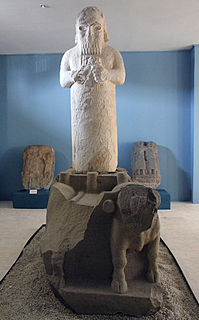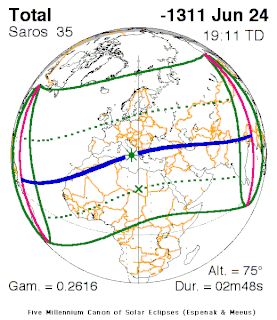 W
WThe Assyrian eclipse, also known as the Bur-Sagale eclipse, is a solar eclipse recorded in Assyrian eponym lists, most likely dating the ninth year of the reign of king Ashur-dan III. The eclipse is identified with the one that occurred on 15 June 763 BC.
 W
WThe Çineköy inscription is an ancient bilingual inscription, written in Hieroglyphic Luwian and Phoenician languages. The inscription is dated to the second half of the 8th century BCE. It was uncovered in 1997 near the village of Çine, that is located some 30 km south of Adana, capital city of the Adana Province in southern Turkey.
 W
WThe middle chronology is one chronology of the Near Eastern Bronze and Early Iron Age, which fixes the reign of Hammurabi to 1792–1750 BCE and the sack of Babylon to 1595 BCE.
 W
WThe solar eclipse mentioned in a text dating to the reign of Mursili II could be of great importance for the absolute chronology of the Hittite Empire within the chronology of the Ancient Near East. The text records that in the tenth year of Mursili's reign, "the Sun gave a sign", just as the king was about to launch a campaign against the Kingdom of Azzi-Hayasa in north-eastern Anatolia.
 W
WPanbabylonism is the school of thought that considered the cultures and religions of the Middle East and civilization in general to be ultimately derived from Babylonian myths which in turn they viewed as being based on Babylonian astronomy, often in hidden ways.
 W
WSino-Babylonianism is a theory now rejected by most scholars that in the third millennium B.C. the Babylonian region provided the essential elements of material civilization and language to what is now China. Albert Terrien de Lacouperie (1845–1894) first proposed that a massive migration brought the basic elements of early civilization to China, but in this original form the theory was largely discredited. In the early 20th century, Sinocentric arguments, sometimes based on Hua–Yi distinction appealed to Chinese intellectuals who wanted to believe that the Yellow Emperor and other figures were historical, not myths. Others reacted to the extent of denying that there were foreign elements in early China. In the late 20th and early 21st century, scholars have used newly excavated archeological evidence to argue that some particular elements of ancient Chinese civilization were carried from western or central Asia into China and that there are linguistic ties between the two sides of the Asian continent.
 W
WUruk, also known as Warka, was an ancient city of Sumer situated east of the present bed of the Euphrates River on the dried-up ancient channel of the Euphrates 30 km (19 mi) east of modern Samawah, Al-Muthannā, Iraq.